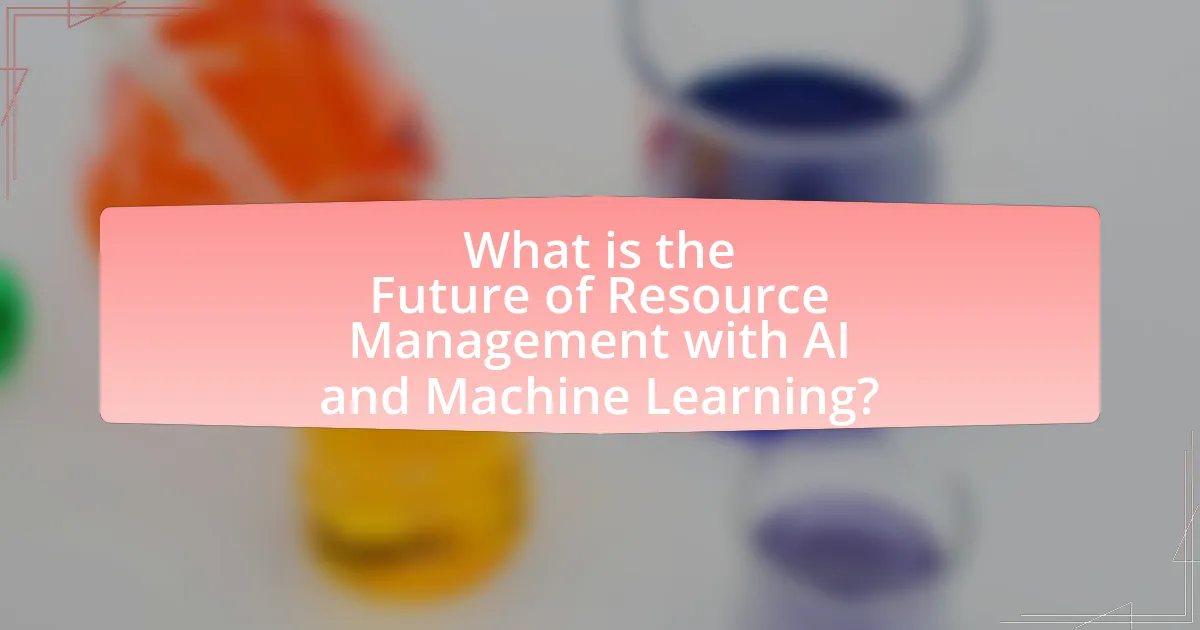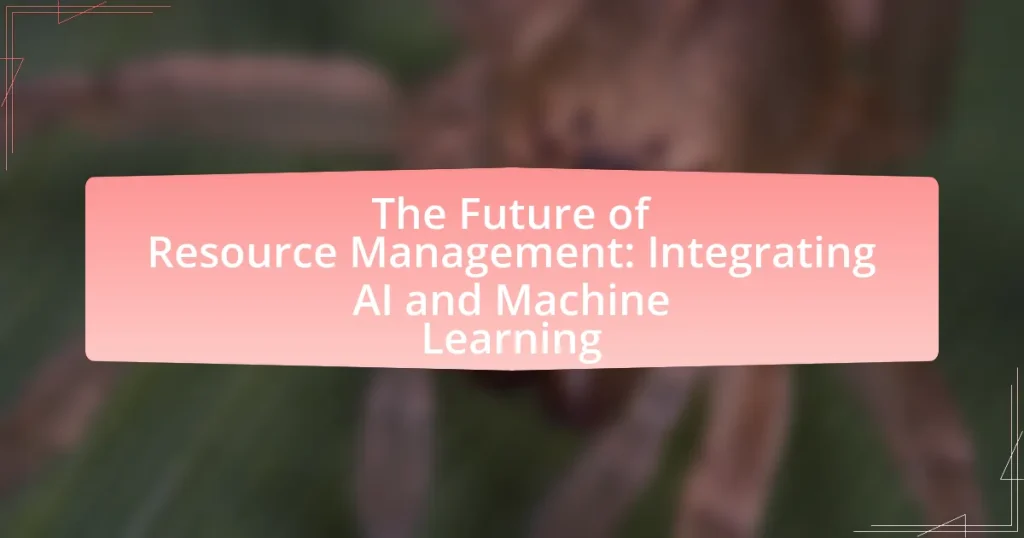The article focuses on the future of resource management through the integration of Artificial Intelligence (AI) and Machine Learning (ML). It highlights how these technologies enhance efficiency, optimize decision-making, and enable predictive analytics, leading to significant operational cost reductions and improved productivity. Key discussions include the specific technologies driving this transformation, the challenges faced by traditional resource management, and the potential impacts on sustainability and environmental management. Additionally, the article outlines best practices for successful implementation, common pitfalls to avoid, and strategies for fostering a culture of innovation within organizations.

What is the Future of Resource Management with AI and Machine Learning?
The future of resource management with AI and machine learning involves enhanced efficiency, predictive analytics, and optimized decision-making processes. AI and machine learning algorithms can analyze vast amounts of data to forecast resource needs, identify inefficiencies, and automate routine tasks. For instance, a study by McKinsey & Company indicates that organizations implementing AI in resource management can achieve up to a 30% reduction in operational costs. This capability allows businesses to allocate resources more effectively, respond to market changes swiftly, and improve overall productivity. As AI technologies continue to evolve, their integration into resource management will likely lead to more sustainable practices and innovative solutions across various industries.
How are AI and Machine Learning transforming resource management?
AI and Machine Learning are transforming resource management by enabling predictive analytics, optimizing resource allocation, and enhancing decision-making processes. These technologies analyze vast amounts of data to forecast demand, identify inefficiencies, and suggest optimal resource distribution strategies. For instance, a study by McKinsey & Company found that organizations using AI in resource management can improve efficiency by up to 20%. Additionally, AI-driven tools can automate routine tasks, allowing managers to focus on strategic planning and innovation, thereby increasing overall productivity and reducing operational costs.
What specific technologies are driving this transformation?
Artificial Intelligence (AI) and Machine Learning (ML) are the specific technologies driving the transformation in resource management. AI algorithms analyze vast datasets to optimize resource allocation, while ML models predict future resource needs based on historical data. For instance, a study by McKinsey & Company highlights that companies leveraging AI in resource management can improve efficiency by up to 30%. This demonstrates the significant impact of these technologies on enhancing decision-making processes and operational efficiency in resource management.
How do AI and Machine Learning improve decision-making in resource management?
AI and Machine Learning enhance decision-making in resource management by providing data-driven insights that optimize resource allocation and usage. These technologies analyze vast amounts of data to identify patterns and predict future resource needs, enabling managers to make informed decisions. For instance, a study by McKinsey & Company found that organizations using AI in resource management can improve efficiency by up to 20%, as AI algorithms can forecast demand and supply fluctuations more accurately than traditional methods. This predictive capability allows for proactive adjustments in resource distribution, reducing waste and improving overall operational effectiveness.
Why is integrating AI and Machine Learning essential for resource management?
Integrating AI and Machine Learning is essential for resource management because these technologies enhance decision-making and optimize resource allocation. AI algorithms analyze vast datasets to identify patterns and predict future resource needs, leading to more efficient use of materials and energy. For instance, a study by McKinsey & Company found that companies implementing AI in their operations could improve productivity by up to 40%. This capability allows organizations to reduce waste, lower costs, and improve sustainability, making AI and Machine Learning critical components in modern resource management strategies.
What challenges does traditional resource management face?
Traditional resource management faces challenges such as inefficiency, lack of real-time data, and difficulty in adapting to changing conditions. These issues stem from reliance on outdated methods and tools that do not leverage modern technology. For instance, traditional systems often depend on manual processes, leading to delays and errors in resource allocation. Additionally, the absence of real-time data hinders decision-making, as managers cannot respond promptly to fluctuations in demand or supply. Furthermore, traditional approaches struggle to integrate new technologies, making it hard to optimize resource use effectively. These challenges highlight the need for innovative solutions, such as AI and machine learning, to enhance resource management practices.
How can AI and Machine Learning address these challenges?
AI and Machine Learning can address challenges in resource management by optimizing decision-making processes and enhancing predictive capabilities. These technologies analyze vast amounts of data to identify patterns and trends, enabling organizations to allocate resources more efficiently. For instance, a study by McKinsey & Company found that companies using AI for resource management can improve operational efficiency by up to 20%. Additionally, Machine Learning algorithms can forecast demand and supply fluctuations, allowing for proactive adjustments in resource allocation, which minimizes waste and maximizes productivity.
What are the potential impacts of AI and Machine Learning on resource management?
AI and Machine Learning significantly enhance resource management by optimizing allocation, improving efficiency, and enabling predictive analytics. These technologies analyze vast datasets to identify patterns and trends, allowing organizations to make data-driven decisions that reduce waste and improve resource utilization. For instance, a study by McKinsey & Company found that AI can increase productivity in resource-intensive industries by up to 20%, demonstrating its potential to transform operational processes. Additionally, AI-driven tools can forecast demand more accurately, leading to better inventory management and reduced costs. Overall, the integration of AI and Machine Learning in resource management leads to more sustainable practices and improved economic outcomes.
How will these technologies affect efficiency and productivity?
AI and machine learning technologies will significantly enhance efficiency and productivity by automating routine tasks and optimizing resource allocation. For instance, AI algorithms can analyze vast datasets to identify patterns and predict outcomes, allowing organizations to make informed decisions quickly. According to a McKinsey report, companies that integrate AI into their operations can increase productivity by up to 40% by streamlining processes and reducing operational costs. This automation not only frees up human resources for more strategic tasks but also minimizes errors, leading to improved overall performance.
What are the implications for sustainability and environmental management?
The implications for sustainability and environmental management include enhanced resource efficiency and improved decision-making processes. Integrating AI and machine learning allows for real-time data analysis, which can optimize energy consumption and reduce waste. For instance, a study by the International Energy Agency found that AI applications in energy management could lead to a 10-20% reduction in energy use in buildings. Additionally, machine learning algorithms can predict environmental impacts, enabling proactive measures to mitigate negative effects. This integration supports sustainable practices by promoting conservation and reducing the carbon footprint, ultimately contributing to long-term environmental health.
How can organizations effectively implement AI and Machine Learning in resource management?
Organizations can effectively implement AI and Machine Learning in resource management by first identifying specific use cases that align with their operational goals, such as optimizing inventory levels or predicting maintenance needs. By leveraging historical data and real-time analytics, organizations can train machine learning models to enhance decision-making processes. For instance, a study by McKinsey & Company found that companies using AI in supply chain management can reduce costs by 20% to 30% through improved forecasting and inventory management. Additionally, integrating AI tools with existing resource management systems ensures seamless data flow and enhances overall efficiency.
What are the key considerations for successful integration?
Successful integration of AI and machine learning into resource management requires clear objectives, data quality, stakeholder engagement, and continuous evaluation. Clear objectives ensure that the integration aligns with organizational goals, while high-quality data is essential for accurate model training and decision-making. Engaging stakeholders fosters collaboration and addresses concerns, facilitating smoother implementation. Continuous evaluation allows for adjustments based on performance metrics, ensuring the integration remains effective and relevant. These considerations are supported by industry studies indicating that organizations with defined goals and strong data governance achieve higher success rates in AI integration.
What skills and training are necessary for staff?
Staff in resource management, particularly in the context of integrating AI and machine learning, require skills in data analysis, programming, and machine learning algorithms. Training in these areas equips staff to effectively utilize AI tools, interpret data insights, and implement machine learning models. For instance, proficiency in programming languages such as Python or R is essential, as these are commonly used for data manipulation and machine learning tasks. Additionally, understanding statistical methods and data visualization techniques enhances decision-making capabilities. Research indicates that organizations that invest in training their staff in these skills see a significant increase in productivity and innovation, as highlighted in the report “The Future of Work: Skills and Training for the AI Era” by the World Economic Forum.
How can organizations measure the success of AI and Machine Learning initiatives?
Organizations can measure the success of AI and Machine Learning initiatives through key performance indicators (KPIs) such as accuracy, return on investment (ROI), and user satisfaction. Accuracy quantifies the effectiveness of AI models by comparing predicted outcomes to actual results, with benchmarks often set based on industry standards. ROI assesses the financial benefits gained from AI initiatives relative to their costs, providing a clear metric for financial success. User satisfaction is gauged through surveys and feedback, reflecting how well the AI solutions meet user needs and expectations. According to a McKinsey report, organizations that effectively measure these KPIs can achieve up to 20% higher performance in their AI projects compared to those that do not.
What are the best practices for leveraging AI and Machine Learning in resource management?
The best practices for leveraging AI and Machine Learning in resource management include data-driven decision-making, predictive analytics, and continuous monitoring. Data-driven decision-making ensures that resource allocation is based on accurate and relevant data, which enhances efficiency and effectiveness. Predictive analytics utilizes historical data to forecast future resource needs, allowing organizations to proactively manage resources rather than reactively responding to shortages or surpluses. Continuous monitoring involves real-time tracking of resource usage and performance metrics, enabling timely adjustments and optimization of resource allocation. These practices are supported by studies showing that organizations implementing AI-driven resource management can achieve up to a 30% reduction in operational costs and a significant increase in resource utilization efficiency.
How can organizations ensure data quality and integrity?
Organizations can ensure data quality and integrity by implementing robust data governance frameworks, which include standardized data entry processes, regular data audits, and validation checks. These frameworks help maintain consistency and accuracy across datasets, reducing errors and discrepancies. For instance, a study by the Data Management Association found that organizations with strong data governance practices experience 30% fewer data quality issues. Additionally, leveraging AI and machine learning tools can automate data cleansing and anomaly detection, further enhancing data integrity by identifying and correcting errors in real-time.
What strategies can be employed to foster a culture of innovation?
To foster a culture of innovation, organizations should implement strategies such as encouraging open communication, promoting cross-functional collaboration, and providing resources for experimentation. Open communication allows employees to share ideas freely, which can lead to creative solutions. Cross-functional collaboration breaks down silos, enabling diverse perspectives to contribute to innovation. Additionally, allocating resources for experimentation, such as time and funding for pilot projects, empowers employees to explore new concepts without the fear of failure. Research by the Harvard Business Review indicates that companies with a strong culture of innovation see 30% higher revenue growth compared to their competitors, demonstrating the effectiveness of these strategies in driving innovation.
What common pitfalls should organizations avoid when integrating AI and Machine Learning?
Organizations should avoid the common pitfalls of insufficient data quality, lack of clear objectives, and inadequate change management when integrating AI and Machine Learning. Insufficient data quality can lead to inaccurate models, as AI systems rely heavily on the data they are trained on; for instance, a study by McKinsey found that poor data quality can cost organizations up to 30% of their revenue. Lack of clear objectives can result in misaligned efforts and wasted resources, as organizations may not know what specific problems they are trying to solve with AI. Additionally, inadequate change management can hinder the adoption of AI technologies, as employees may resist new systems without proper training and support, leading to a failure in realizing the potential benefits of AI integration.
How can organizations stay ahead in the evolving landscape of resource management?
Organizations can stay ahead in the evolving landscape of resource management by integrating AI and machine learning technologies into their operations. These technologies enable organizations to analyze vast amounts of data in real-time, optimize resource allocation, and predict future resource needs with greater accuracy. For instance, a study by McKinsey & Company found that companies leveraging AI in their resource management processes can improve efficiency by up to 20%. By adopting these advanced technologies, organizations can enhance decision-making, reduce costs, and respond more swiftly to market changes, thereby maintaining a competitive edge.


